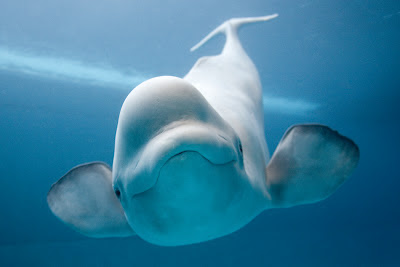The Keel-billed Toucan also known as Sulphur-breasted Toucan or Rainbow-billed Toucan is a colourful Latin American member of the toucan family. It is the national bird of Belize. Keel-billed Toucans ranges in length from around 17 to 22 inches (42–55 cm). Their large and colourful bill averages around 5-6 in (12–15 cm), about one-third of its length. It typically weighs about 380-500 grams. While the bill seems large and cumbersome, it is in fact a spongy, hollow bone covered in keratin, a very light and hard protein.
The plumage of the Keel-billed Toucan is mainly black with a yellow neck and chest. Molting occurs once per year. It has blue feet and red feathers at the tip of its tail. The bill is mainly green with a red tip and orange sides. Keel-billed toucans have zygodactyl feet (or feet with toes facing in different directions) - two toes face forward and two face back. Because toucans spend a large portion of time in the trees, this helps the birds to stay on the branches of the trees and hop from one branch to another.
Range
The Keel-billed Toucan can be found from Southern Mexico to Venezuela and Colombia (Belize; Colombia; Costa Rica; Guatemala; Honduras; Mexico; Nicaragua; Panama; Venezuela) It roosts in the canopies of tropical, subtropical, and lowland rainforests, up to altitudes of 1,900 m.
Ecology
The Keel-billed Toucan roosts in holes in trees, often with several other toucans. This can be very cramped, so the birds tuck their tails and beaks under their bodies to conserve space while sleeping. Adding to the lack of space, the bottoms of the holes are often covered with pits from the fruit the toucans have eaten.
Like many toucans, Keel-billed is a very social bird, rarely seen alone. It travels in small flocks of approximately six to twelve individuals through lowland rainforests; it is a poor flyer, and moves mostly by hopping through trees. It has a family structure within the group. Birds will often "duel" with each other using their bills, and throw fruit into each other's mouths. Keel-billed Toucans live together in these groups, often sharing cramped living quarters of holes in trees.
Status
This species has a very large range, and hence does not approach the thresholds for Vulnerable under the range size criterion (Extent of Occurrence <20,000 km.Sq combined with a declining or fluctuating range size, habitat extent/quality, or population size and a small number of locations or severe fragmentation). The population size is very large, and hence does not approach the thresholds for Vulnerable under the population size criterion (<10,000 mature individuals with a continuing decline estimated to be >10% in ten years or three generations, or with a specified population structure). For these reasons the species is evaluated as Least Concern. Listed in The U.S. Wild Bird Act and in CITES - endangered and threatened animals.
Biology
The diet of Keel-billed Toucans consists mostly of a wide range of fruit,[8] but may also include insects, eggs, and reptiles. The bill, surprisingly dexterous, allows this toucan to utilize a large variety of fruit that might not otherwise be reached. When eating the fruit, it uses its bill to dissect the fruit, and then tosses its head back to swallow the fruit whole.
A female keel billed toucan lays between 1 and 5 eggs in a hollow tree, which usually hatch within a few weeks. Both the male and female keel billed toucan incubate the eggs and both keel billed toucan parents also feed and look after their keel billed toucan chicks until they are old enough and strong enough to fend for themselves.
After hatching, the male and female again take turns feeding the chicks. When the chicks hatch, they have no feathers, and have their eyes closed for approximately 3 weeks. The chicks have adequately formed heel pads, which assist on the pit-covered bottom of the nest. The chicks stay in their nest for approximately eight to nine weeks while their bills develop fully and they are ready to fledge from the nest.
After hatching, the male and female again take turns feeding the chicks. When the chicks hatch, they have no feathers, and have their eyes closed for approximately 3 weeks. The chicks have adequately formed heel pads, which assist on the pit-covered bottom of the nest. The chicks stay in their nest for approximately eight to nine weeks while their bills develop fully and they are ready to fledge from the nest.
Threat
This colorful bird is taken from the wild to satisfy demand in the local and international cage bird trade. This exploitation, in combination with the loss and degradation of forest habitat, threatens the survival of the toucans. Forests within the toucan’s range are being lost to uncontrolled human colonization, massive logging concessions, cattle grazing, mining, coca and palm cultivation conservation.
The Keel billed toucan is listed on Appendix III of the Convention on International Trade in Endangered Species (CITES), meaning that Colombia has asked other CITES member countries for assistance in controlling the trade. This may regulate legal trade, but measures to control illegal trade are still required, and considered essential for the protection of these toucans.
References
http://en.wikipedia.org/wiki/Keel-billed_Toucan
http://a-z-animals.com/animals/keel-billed-toucan/
http://whozoo.org/students/jenthu/toucan.html
http://www.enchantedlearning.com/subjects/birds/printouts/Toucancoloring.shtml
http://www.anywherecostarica.com/flora-fauna/bird/keel-billed-toucan


























